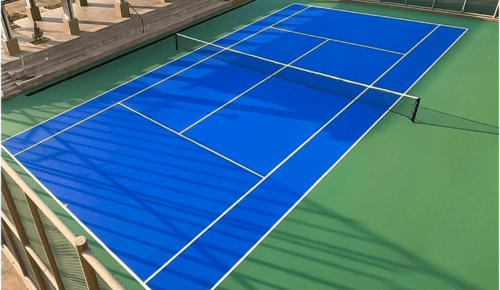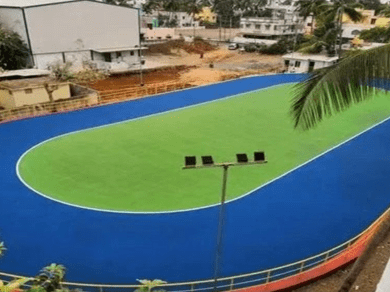How to Choose the Floor for a Tennis Court: From Materials to Installation

Choosing the right tennis court flooring is an essential step in creating a high-quality and durable playing surface. Whether you’re building a professional-level court or a recreational one, the flooring material will significantly impact the game’s playability, player comfort, and long-term maintenance needs. With various options available, it’s important to consider factors such as material durability, cost, maintenance requirements, and the type of play you envision. In this post, we will guide you through the entire process of selecting the best floor for a tennis court, from material choice to installation.
Understand the Different Types of Tennis Court Flooring Materials
The first step in choosing the right flooring is understanding the different types of sports flooring materials commonly used for tennis courts. These materials can be categorized into four primary types: grass, clay, hard court, and synthetic surfaces.
Grass Courts
Grass courts are often considered the traditional surface for tennis, especially popular for major events like Wimbledon. Grass courts offer a soft playing surface with a unique, fast-paced game. However, they require a lot of maintenance, including mowing, irrigation, and reseeding to keep the court in prime condition. The downside is the high maintenance cost, making it less ideal for commercial or frequent use courts.
Clay Courts
Clay courts provide a slower game with a high bounce, making them a favorite for players who prefer a more strategic style of play. They are commonly seen in tournaments like the French Open. The advantage of clay is that it is relatively easy to maintain compared to grass; however, it still requires periodic resurfacing. On the downside, clay courts can become muddy and slippery in rainy conditions.
Hard Courts (Acrylic or Polyurethane)
Hard courts, typically made from acrylic or polyurethane surfaces, are the most common type of tennis court flooring for both recreational and professional use. These courts provide a fast-paced game with a consistent bounce. They are also known for being low maintenance and long-lasting. Acrylic coatings are often applied over an asphalt or concrete base, which enhances durability and resistance to wear.
Synthetic Turf
Synthetic turf has emerged as a popular choice due to its resemblance to natural grass but with lower maintenance requirements. The surface is designed for fast play, and it can be customized with different types of infill material to control the playing speed. Synthetic turf is versatile and can be used for both tennis and multi-sport courts.
Consider the Playing Characteristics of Tennis Court Flooring
When choosing a sports court flooring for tennis, the playing characteristics should be a primary consideration. These include the speed of play, the type of bounce, and the surface’s impact on players’ joints.
- Play Speed: Hard courts offer the fastest game, while clay courts are slower, allowing for more time to react to the ball. Grass courts provide a mixture of both, but they tend to wear down faster with heavy use. Synthetic turf provides a balance and can be adjusted based on infill materials.
- Bounce: The bounce of the ball differs from surface to surface. Grass tends to create a lower, erratic bounce, while clay offers a higher, slower bounce. Hard courts produce a consistent bounce, making them a great option for professional matches.
- Impact on Joints: Some surfaces, like hard courts, can be more challenging on players’ joints due to the rigid surface. In contrast, grass and clay courts are generally more forgiving, providing a softer surface that reduces the risk of injuries.
Assess Your Budget and Maintenance Needs of Tennis Court Surface
The cost of flooring materials and installation varies significantly depending on the type of surface you choose. Here’s a breakdown of general costs:
- Grass Courts: The initial cost of installing a grass court is relatively high due to irrigation and seeding needs. Ongoing maintenance costs are also steep, including regular mowing and reseeding.
- Clay Courts: Clay courts are more affordable to install initially, but their maintenance can be quite costly, especially in terms of regular resurfacing and upkeep.
- Hard Courts: Hard courts are an economical choice in the long term. Installation costs are moderate, and their low-maintenance nature makes them an attractive option for owners who want durability without high upkeep costs.
- Synthetic Turf: Synthetic turf is a mid-range investment, both in terms of installation and maintenance. While it requires occasional brushing and infill adjustments, it does not require watering, mowing, or other labor-intensive tasks.
When considering costs, it’s essential to factor in long-term expenses, including maintenance and any repairs required over time.
Installation Process of Tennis Court Flooring
The tennis court installation process will vary depending on the type of flooring you choose. Here’s what to expect:
- Grass Courts: Grass courts require meticulous preparation, including soil conditioning, drainage systems, and irrigation installation. Proper leveling is also essential for a consistent playing surface.
- Clay Courts: Installing a clay court requires creating a proper foundation and ensuring good drainage. The surface must be smoothed and compacted for a professional-level playing area.
- Hard Courts: Hard courts are usually installed over an asphalt or concrete base. After preparing the base, the court is coated with an acrylic layer. The installation process is relatively quick compared to other surface types.
- Synthetic Turf: Synthetic turf installation involves laying down the turf and adding an appropriate infill to ensure the surface mimics the playing qualities of natural grass. It requires less preparation than traditional grass but still demands a level and well-drained base.
Hire a Professional for Tennis Court Installation
Regardless of which surface you choose, it’s essential to hire experienced sports flooring expert to install your tennis court flooring. Improper installation can result in uneven surfaces, drainage issues, and premature wear. A professional installer will ensure that the court is prepared correctly, the materials are applied evenly, and the surface performs as expected.
Conclusion
Choosing the right floor for a tennis court involves balancing your needs, budget, and long-term goals. Consider the type of play you want, the maintenance demands of each material, and your budget constraints. Hard courts, with their durability and low maintenance, are often the go-to choice for many tennis enthusiasts. However, for those seeking a more traditional or strategic game, grass or clay courts may be more suitable. Ultimately, the key to a successful installation is working with experienced professionals who can ensure that your court is built to last and provides the best playing experience possible.
